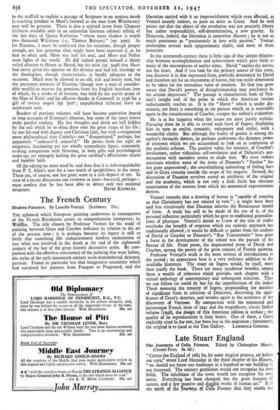The French Century
Modern Painters. By Lionello Venturi. (Scribners. 21s.)
THE upheaval which European painting underwent in consequence of the French Revolution awaits its comprehensive interpreter, its Wolfflin. The title chosen by Professor Venturi for his study of painting between Goya and Courbet indicates its relation to the art of the present time ; it is perhaps because its legacy is still so lively that something like embarrassment hinders examination of just what was involved in the death at the end of the eighteenth century of the last of the great historic decorative styles. By com- parison with the effortless consistency of the painting that went before, the styles of the early nineteenth century seem dismembered, dejected, partisan. France in particular lost that imaginative unanimity which had sustained her painters from Fouquet to Fragonard, and the
liberation carried with it an impoverishment which even affected, as Venturi acutely notices, so pure an artist as Corot. And he well points out that the object of the revolution was not precisely liberty but rather responsibility, self-determination, a new gravity. In Delacroix, indeed, the liberation is somewhat illusory ; he is not so much passionate as " passionately in love with passion." Venturi unsheathes several such epigrammatic shafts, and most of them penetrate.
In the nineteenth century there is little sign of that simple relation- ship between accomplishment and achievement which gave birth to many of the masterpieces of earlier times. David " excites the nerves not the heart. And if you look for the primary source of this error, you discover it in that expressed form, perfectly dominated by David and therefore apt for an instrument of horror, but too easily dominated to be taken for the tremulous voice of emotion. So that you grow aware that David's powers of draughtsmanship may perchance be his artistic impotence." The passage is characteristic both of Ven- turi's insight and of the prose in which this American version unfortunately reaches us. It is the " Marat " which is under dis- cussion, yet there is something in the picture which, as is noticeable again in the consideration of Courbet, escapes the author's evaluation.
He is at his happiest when the issues are most purely stylistic. Pursuing them he is able to reveal each facet of Ingres, displaying him in turn as realist, romantic, voluptuary and stylist, with a wonderful clarity. But although the frailty of genius is among the author's favourite themes, he perhaps underrates the dynamic power of elements which we are accustomed to look on as confusions of the aesthetic scheme. The positive value, for instance, of Courbet's involuntary, rather ridiculous self-revelation and of Delacroix's pre- occupation with narrative seems to elude him. We even remain uncertain whether some of the irony of Daumier's " Pardon " has not gone unperceived ; the overwhelming unleashing of feeling here and in Goya remains outside the scope of his enquiry. Instead, the discussion of Daumier revolves round an antithesis of the original and the academic, which is not only a little facile but obscures examination of the sources from which his anatomical expressionism derives.
Venturi remarks that a drawing of horses is " capable of assuring us that Christianity has not existed in vain"; might have been said less circuitously that Daumier inherits the Renaissance mould of form. A study has still to be made of his use of it, of the personal inflection particularly which he gave to traditional generalisa- tions of physique. Venturi's denial to Corot of the title of realist overlooks the breadth of response which the realistic approach has traditionally allowed ; it would be difficult to gather from his analysis of David or Courbet or Daumier's " Rue Transnomain " how great a force in the development of the school was the pursuit of the flavour of life. From prose, the impassioned prose of David and Courbet, sprang the poetry of the great century of French painting.
Professor Venturi's work is the most serious of introductions to the period ; its appearance here is a very welcome addition to the available literature. The essay on Ingres would, by itself, more than justify the book. There are many incidental benefits, among
them a wealth of reference which provides each chapter with a virtual anthology of contemporary and subsequent criticism. Thus we can follow (or could do but for the imperfections of the index) Thore assessing the tenacity of Ingres, propounding the doctrine of significant form in criticism of Delacroix, discerning the signi-
ficance of Corot's sketches, and wonder .again at the acuteness of the
discoverer of Vermeer. By comparison with the mannered and picturesque French issue of 1941 and the magnificent, classic Italian volume (1946), the design of this American edition is archaic; quality of its reproductions is little better. One of them, a rot explicitly cited in the text, has been lost in the migration ; fortunately,
the original is to hand at the Tate Gallery. LAWRENCE GOWING.


































 Previous page
Previous page